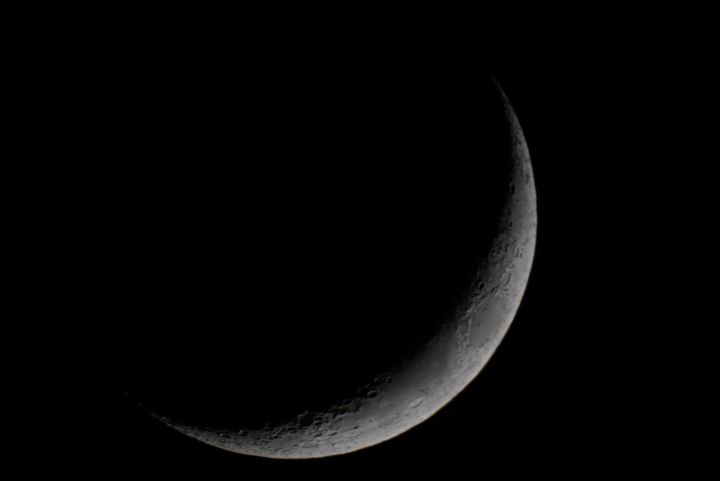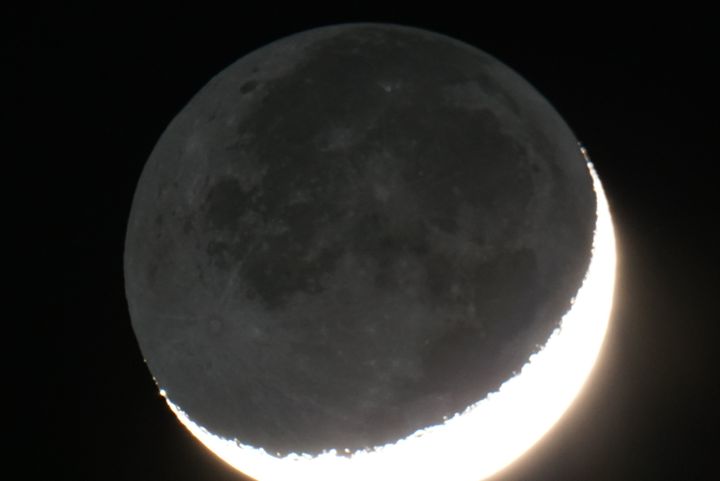
Apollo 17 Panorama
The Moon is interesting for many obvious reasons. It contributes to tides, affected the evolution of nocturnal animals, influenced the development of life in tidal shallows, and more. But among the reasons it is utterly magnificent is for what it teaches us each and every month just by its appearance. There is much to be learned by simple observation.
The moon is a waxing crescent now and is going to become more and more illuminated as the moon continues in its orbit. We know that the moon has different 'phases', appearing as a crescent first, then a few days later as 'first quarter' , named that way because it is one quarter of the way around the Earth at that point in its orbit. Many people call it the ‘half moon’ because it appears from Earth to be half lit. But the truth is that it is always 50% illuminated, we just cant see that other side.
Next in a few more days the moon reaches the 'waxing Gibbous' phase where it appears to us on Earth as not quite full.Then of course it becomes full Moon where we see the full face of the moon Illuminated, followed by a decrease in the Moon's phase once again until the Moon is in the daytime sky and not visible at night for a few days. This is the New Moon.
BUT, did you know that the Moon is NOT the only body we see that shows PHASES? Both Mercury and Venus, closer to the Sun, have phases as well. In 1610 Galileo first saw that Venus went through phases similar to the moon. This at the time was problematic. Their held belief at the time was based on the Ptolemaic view that suggested that the Earth was the CENTER of the universe and that all other bodies revolved around it. But if true, then Venus could NOT have shown phases which it clearly did. So Galileo and later Copernicus suggested that the Earth was NOT the center of the Universe. Clearly this landed them in some hot water.
But there is no hiding our past ignorance and eventually it was recognized that the Earth was farther out from the Sun than Venus and Mercury. Today when we look at the illuminated crescent Moon we can clearly recognize it as a spherical body with its curved shadows belying that fact. Flat Earth believers seem to relish their ignorance of this, the most obvious rudimentary lesson the Universe teaches us each and every month.
That said lets look at the pictures. Starting with the small object photo below note that it looks like a 'first quarter' phase of a small Moon. This is Venus tonight and like Galileo we are seeing this phase of Venus showcased for us here. I took all of these images in the last few hours here in Terryville CT through my large backyard telescope that I use when I want to get some good photos. This combo of Venus and the Moon was just took good to pass up. I took thirty or forty shots of other deep sky wonders as well but tonight its about the Moon and Venus!

Venus seen at what appears to be ‘50%’ illuminated
In the Moon shots we see some very interesting effects too. In the first photo where the moon crescent is clearly seen against the darker background, the curvature of the shadow is a dead giveaway that the moon is a sphere illuminated by the much further and distant Sun. The photo also shows the craters illuminated by shallow angle light raking across them and making them appear fairly ominous. At Full Moon we do not get to see shadows because the Sun is on the Western horizon, the Moon on the Eastern horizon and the light hits straight down on the Moon as seen from the Earth leaving no shadow of any appreciable amount that we can see from out point of view.

Waxing Crescent Moon
So at Full Moon, Moon watchers are probably inside watching reruns of the A-Team or Battlestar Galactica for instance as the Lunar seeing just isnt great at all. But at phases leading up to Full and leading away from Full, the shadows illustrate the harsh topography of that airless world. And they are fun to photograph!
In the below photo I exposed for the UNLIT side of the moon. What does that mean? Well, what I mean is that the areas on the Moon that are not lit by direct sunlight can still be seen, How is that possible? The answer lies in simple physics... In fact its simple reflection. The Moon is reflecting the EARTH's own light because from the Moon, the Earth appears brightly lit.

“Earthshine”
Thus the 'Earthshine' as we call it visible on the Moon is faint but definitely there. Note the Earthshine that is visible in the second photo where the lit limb of the Moon is vastly overexposed but the 'dark' part of the Moon looks like a faint but normal Moon with which we are familiar. Those who have good 3D skills and recognition can see that this is a spherical ball that is partially illuminated by the Sun. (I still cant believe Flat Earth science free folks cant look at this and see it for what it is...)
The last point I want to make is in regard to the strange dance that the Moon and the Earth go through every month. We all know that we always see the same side of the Moon. We never see the any significant amount of the dark side. The Moon has slight 'wobbles' that afford us little glimpses of a little bit more but these are regular and well known wobbles.
The fact that we see the same side is due to a mechanism that can happen when any Moon is too close to its host planet: The planet 'locks' gravitational forces so that the Moon becomes held in a forever tidal embrace keeping the same side facing the host planet. This can happen with planets too close to stars too. Such is Mercury's fate. Mercury is tidally locked to the Sun, always showing the same side to the Sun.
Indeed, many of our favorite Exoplanets around the cooler in temperature M type stars where a vast majority of planets lie, are themselves tidally locked to the star. M stars are so cool that their habitable zone are very close to the star itself. Planets that have the possibility of supporting life may very well be 'one sided' creating truly alien planetary ecosystems.
I hope you enjoyed this little little leap into Lunarity!
